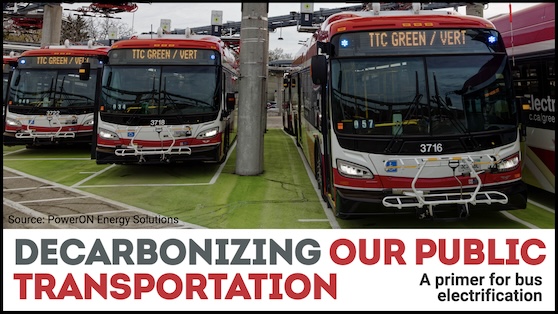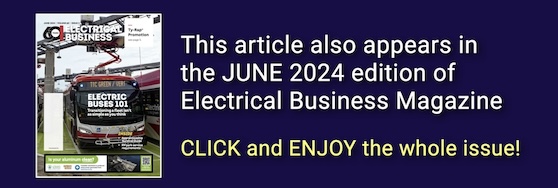
Articles
Cleantech
Electrified Transport
Features
Articles
Cleantech
In-Depth
Vehicles
Decarbonizing our public transportation – A primer for bus electrification
July 15, 2024 | By PowerON Energy Solutions
 The Toronto Transit Commission and PowerON Energy Solutions unveil 10 newly commissioned, battery-electric bus charging pantographs as part of a proof-of-concept at the Birchmount Garage (April 2023). Source: PowerOn Energy Solutions.
The Toronto Transit Commission and PowerON Energy Solutions unveil 10 newly commissioned, battery-electric bus charging pantographs as part of a proof-of-concept at the Birchmount Garage (April 2023). Source: PowerOn Energy Solutions. July 15, 2024 – As the global push for sustainability gathers steam, transit bus operators have an opportunity to contribute meaningfully to the decarbonization of transportation. Electrification of transit buses presents an immediate and impactful solution for reducing greenhouse gas emissions, and air and noise pollution for local communities.
However, transitioning from fossil fuel-powered buses to electric alternatives is not as simple as replacing one for the other and installing chargers. It requires an understanding of the available types of electric buses, their corresponding charging systems, and best practices for a seamless electrification process.
Types of electric buses
Battery-electric buses (BEBs)
Powered entirely by electricity stored in onboard batteries, BEBs are recharged at charging stations. They offer zero tailpipe emissions and often boast lower operating costs than their fossil-fuel counterparts, but their range between charges is limited by the battery’s capacity, making them ideal for fixed routes with predictable demands.
Hybrid-electric buses (HEBs)
These buses combine an internal combustion engine with an electric propulsion system, using energy stored in batteries for propulsion at lower speeds and the diesel engine at higher speeds. They emit fewer emissions than conventional diesel buses but do not achieve the zero-emission status of BEBs.
Hydrogen fuel cell electric buses (FCEBs)
FCEBs use hydrogen gas to power an electric motor. While they emit only water and heat, the production of hydrogen can generate emissions and can be energy intensive.
Approaches to charging for electric buses
There are two main approaches to charging electric transit buses: depot and opportunity.
The most common method, depot charging, involves the installation of charging infrastructure at the bus depot where buses are charged overnight. This solution works well for BEBs operating on routes where buses are able to achieve the entire daily schedule on a single charge.
For other routes, opportunity charging may offer a more practical solution. Fast-charging infrastructure is installed at endpoints or along the route, allowing buses to top up their battery during driver breaks or layovers. While this method can extend a bus’s daily range, it often requires a larger upfront investment in infrastructure.
Choosing the appropriate charging hardware is as crucial as selecting the right electric bus type for the fleet. Understanding the benefits and distinctions between different types of charging technologies—particularly overhead pantograph charging and DC fast charging—helps for making informed decisions.
Overhead pantographs
A form of opportunity charging, overhead pantographs are a popular solution for high-demand routes where buses need to recharge multiple times throughout the day without returning to the depot. The system works by installing an overhead charging unit at selected stops where the charging process is initiated via a pantograph: a mechanical arm that extends from the charger to connect with the bus.
There are two types of pantograph charging systems: inverted and roof-mounted. Inverted pantographs are attached to the infrastructure, lowering onto the bus for charging. Roof-mounted pantographs are situated on the bus’s roof and rise to connect with the charger.
Overhead pantograph systems offer several benefits. As mentioned, they can be strategically located at endpoints or busy stops, providing buses with more opportunities to recharge and avoiding extended downtime.
And because buses can recharge frequently, they can operate with smaller batteries, reducing the bus’s weight and overall cost. This kind of system is also easy to expand as the fleet grows or route demands change.
DC fast charging
Another form of opportunity charging, DC fast charging provides a rapid energy boost to buses during layovers or between routes. DC fast chargers can deliver a large amount of power quickly—usually 50 kW to 350 kW—directly to the bus’s battery, bypassing the onboard charger for faster charging times.
DC fast charging also boasts several benefits, not the least of which is its ability to recharge a bus’s battery much faster than traditional AC chargers, allowing for more uptime.
These chargers also provide for an easier installation, as they can be installed in existing depots or along routes, making them a versatile option for a variety of transit scenarios. And, by charging rapidly during off-peak hours, DC fast chargers can help mitigate strains on the power grid.
Each charging solution has its unique benefits and applications. The choice between overhead pantograph charging and DC fast charging will depend on the fleet’s specific operational needs, route schedules, and infrastructure capabilities. A comprehensive analysis of these factors will ensure a successful transition to an electrified bus fleet.
Bus fleet electrification best practices
Always begin with a comprehensive review of bus routes, considering factors like distance, topography, and climate, all of which impact a bus’s energy consumption and, by extension, the types of electric buses and charging infrastructure that should be considered.
Speaking of infrastructure, consider the electrical capacity of the transit authority’s depot. If depot charging is being considered, then the facility’s electrical service may need to be upgraded. For opportunity charging, determine the optimal locations for charging stations along bus routes.
Pilot programs (where a few electric buses are tested on select routes to see how they operate in real-world conditions) offer valuable insights that inform the wider rollout.
The transit operator’s workforce will require additional training on these new technologies, as electric buses require different maintenance and operation practices.
Always consider the Total Cost of Ownership (TCO) when purchasing. Electric buses have higher upfront costs (plus related infrastructure), but they often have lower operating and maintenance costs, potentially resulting in a lower TCO over the bus’s service life.
Investigate the myriad federal, provincial, and local incentives that will help the transit authority pay for its electric buses and infrastructure.
Through the Zero-Emission Transit Fund (ZETF), for example, the Government of Canada is investing $2.75 billion over five years to support public transit and school bus operators plan for electrification, support the purchase of 5000 zero-emission buses, and build supporting infrastructure (which includes charging infrastructure and facility upgrades).
Two types of projects are eligible for ZETF funding:
• Planning. Projects include studies, modelling, and feasibility analyses that will support the development of larger-scale capital projects.
• Capital. Eligible projects include buses, charging and refuelling infrastructure, and other ancillary infrastructure needs.
Fleet pride
The journey toward fleet electrification may be complex, but it is a necessary step toward a sustainable future for public transit. With the right strategies and resources, transit bus operators can navigate the electrification process effectively, creating cleaner and and more cost-effective services for their communities.
Contributed by PowerON Energy Solutions, an OPG Company.
You’ll find all Back Issues of Electrical Business Magazine in our Digital Archive.
Print this page
